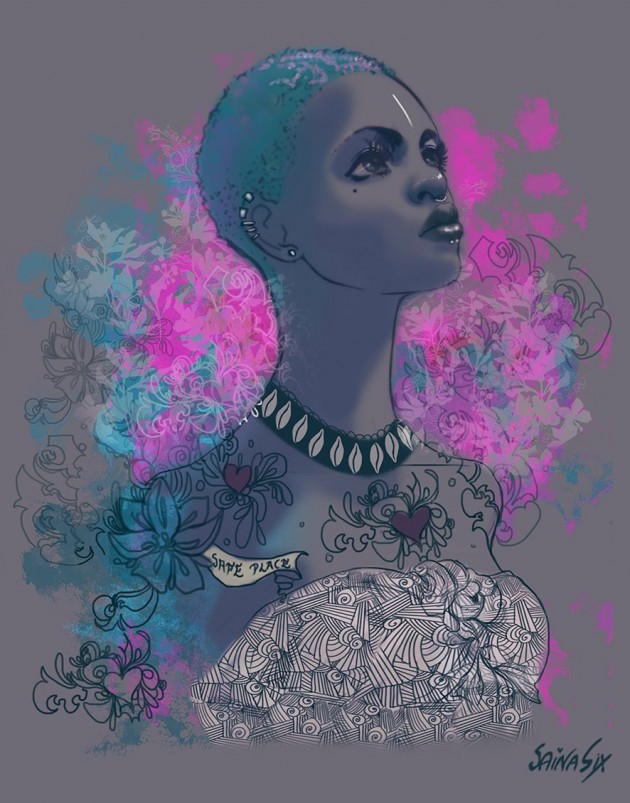As the latest edition of Afro-Punk Fest comes to a close, let’s have a look at a phenomenon that has gone global in less than a decade.
This year’s New York festival featured such heavyweights as Lauryn Hill and Grace Jones, among others under the Brooklyn sun. A few weeks earlier, the first ever edition outside of the US took place in Paris to a packed house at the Trianon.
The story begins with a young Black American.
James Spooner loved a kind of music that many believed was only appreciated by Whites. Punk Rock in the 80s belonged to a universe and used formulas that didn’t seem to correspond socially, culturally or musically to Black artists at that time.
James Spooner was bicoastal before settling in New York with his family at the age of 14. In the abounding and creative metropolis, he met other young music fans. Like him, they were hardcore punk rockers and like him, they were young Blacks who loved the Clash and the Sex Pistols. His racial identity quest would send Spooner to the four corners of the country. The result was a documentary, Afropunk: A rock n roll n***r experience, that was about far more than music and in the purest DIY punk rocker fashion, became a cult reference at film festivals and the point of departure for the AFRO-PUNK movement.
The documentary’s objective was to show young Blacks, who like the director had lived in an environment where they felt isolated, that they were not alone – that Punk Rock was not a musical genre reserved for a single ethnic group.
Furthermore, referring to Black music as a genre, tends to put Black artists is a monolithic bloc as if their music was all the same. Afro-Punk was born to showcase an artistic diversity that mainstream media did not adequately recognize. And to remind us that the roots of rock are in the music that Blacks created. This reappropriation is a small revolution, in the true sense of the word: a return to the original inspirations of the music that has been “whitened” by history.
Today, twelve years after the first festival in Fort Greene, Brooklyn, the movement has become huge and international. Afro-Punk is an unprecedented creative alternative platform where musicians, dancers, painters, filmmakers, designers, photographers and other Black punk rock artists can freely express themselves. And, like other big music festivals such as Coachella or the iconic Woodstock, Afro-Punk is an explosion of styles and trends both on stage and among the audience.
More than a just music festival, Afro-Punk has become a real movement whose actions are both sociocultural and political in scope. It was conceived as a safe space where even the most outlandish individual expressions can feel secure. The rules are: No Sexism, No Racism, No Ageism and No Discrimination based on Handicaps. A veritable manifesto!
The safe space notion continues on the web with about 450,000 Facebook followers. The articles deal with current subjects such as the recent spread of police violence in the US. Visitors have even been able to contribute to Color of Change to help finance an independent investigation into the death of Sandra Bland while in police custody in Texas. The Afro-Punk page also softly influences the collective imagination through its Daily Afro photos, featuring natural hairstyles.
Punk is not dead! Quite the contrary! But if as far as the music is concerned – Jimi Hendrix of course, and protest ideology – breaking down traditional codes, the links are well established but what about punk rock fashion influences from the seventies?
Let’s be real: the trashy mohawks and the London black and white looks were not fashion high points. And we can have a sigh of relief that Afro-Punk artists and followers seem more inspired by Vivienne Westwood, icon of London 70/80s style than by Sid Vicious, founding member of the Sex Pistols.
As we can see in the photography of Phill Knott and with the collective, ArtComesFirst, or the very hip inspired by the style of Basquiat, black and white is still alive.
Leather and the hardcore esthetic show up in rocker jackets and accessories as well as in tattoos.
But color is often more important and brings with it a joyful wave of creativity that sweeps away any possible confusion with an aggressive or exclusive punk rock. As a stylist, I am thrilled to note this creative and diverse generosity. It is a total freedom of expression that causes unusual and sometime improbable style mixtures.
We find numerous traditional African influences in the jewelry, fabrics and hairstyles. These are looks that translate our generations’ willingness to show the most beautiful and the most majestic infuse with an individual flamboyance. “Come as you are,” is one of the festival’s slogans.
Because of this, each look has its own imprint. It is difficult to define an “Afro-Punk style.” It’s free, emancipated from any past or present dictates yet full of personal history.
However, don’t be fooled, this does nt mean that in a society dominated by a marketing where alternative is a style, that Afro-Punk is not a style. So it is not surprising to find the wacky and colorful pairings of Afro-Punk kids on the pages of Vogue or Tatler or in ready-to-wear ads.
How can we be mad at the major brands for their infatuation with Afro-Punk? Woodstock shook the mentalities of Nixon’s America in the 70s and left an indelible mark on the style esthetic of the following decades, Let’s wish long life to Afro-Punk! Punk is not dead!!!!!
Gayanée PIERRE with Rokhaya DIALLO
Many thanks to SainaSix for her beautiful illustrations
Translated by Alberta Wilson

